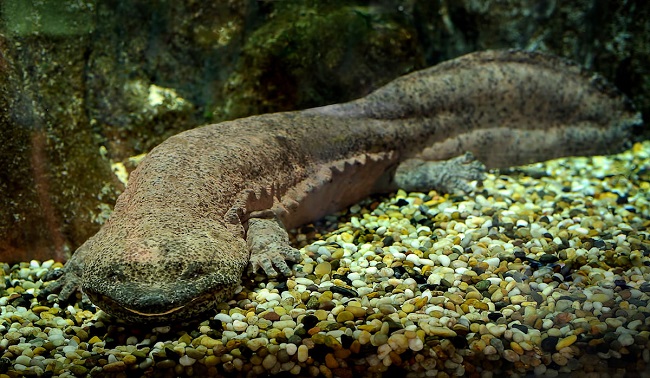
The giant salamander is a large amphibian species that belongs to the family Cryptobranchidae. There are three species of giant salamanders: the Chinese giant salamander (Andrias davidianus), the Japanese giant salamander (Andrias japonicus), and the North American hellbender (Cryptobranchus alleganiensis). These salamanders are some of the largest amphibians in the world, with some individuals reaching lengths of up to 5 feet and weighing over 50 pounds.
Giant salamanders are primarily aquatic and can be found in a variety of freshwater habitats, including rivers, streams, and ponds. They have a flattened body and a broad head with small eyes and large nostrils. They also have a long, powerful tail that they use for swimming, and four short legs with webbed feet.
Giant salamanders are predators, and feed on a variety of prey, including fish, insects, and small mammals. They are also known for their vocalizations, which include grunts, growls, and barks.
Unfortunately, giant salamanders are listed as endangered or critically endangered, primarily due to habitat loss, pollution, and over-harvesting for use in traditional medicine and as a luxury food item in some parts of Asia. Conservation efforts are underway to protect and restore their populations.
Why Giant Salamanders are Called Hellbenders
The North American giant salamander, Cryptobranchus alleganiensis, is commonly known as the hellbender. There are several theories as to how it got its name. One theory is that the rough, wrinkled skin of the salamander resembles the texture of “hell-bent” leather, which was a type of rugged leather used for harnesses and other heavy-duty equipment. Another theory is that the salamander was called a “hellbender” because of its sinuous, undulating movement along the stream bottom, which some observers thought resembled a snake or other creature from the underworld.
9 Fun Facts About Giant Salamanders
Giant salamanders are the largest amphibians in the world, with some species growing up to 5 feet long.
Giant salamanders have poor eyesight, but they have excellent senses of smell and hearing.
These amphibians are nocturnal and spend most of their time hiding in burrows or under rocks in streams and rivers.
Giant salamanders are top predators in their ecosystems and will eat almost anything that they can catch, including fish, insects, and even small mammals.
The Chinese giant salamander is critically endangered due to habitat loss, pollution, and overhunting for use in traditional Chinese medicine.
Japanese giant salamanders are important cultural symbols in Japan and are sometimes kept as pets in households or temples.
Giant salamanders have been known to live for over 50 years in captivity.
These amphibians have a unique ability to regenerate lost body parts, including limbs, tails, and even parts of their spinal cords.
Giant salamanders are relatively slow-moving and are sometimes called “living fossils” because their basic body plan has remained largely unchanged for millions of years.
Where to Find Giant Salamanders in America
The North American giant salamander, also known as the hellbender, can be found in rivers and streams throughout much of the eastern United States, from New York to Georgia and west to Missouri and Arkansas. Hellbenders prefer clear, fast-moving streams with rocky bottoms, where they hide in crevices and under rocks during the day and come out at night to hunt for prey.
Due to habitat loss, pollution, and other threats, hellbender populations have declined significantly in many parts of their range, and they are now listed as endangered or of special concern in many states. As a result, it is important to handle them with care if you encounter them in the wild, and to avoid disturbing their habitat.
If you are interested in seeing or learning more about hellbenders, there are several conservation organizations and nature centers that offer educational programs and exhibits on these fascinating creatures. Some examples include the St. Louis Zoo, the Chattanooga Aquarium, and the North Carolina Zoo.
Related Articles & Free Email Newsletter Sign Up
North American Otters are Among the Most Playful Animals in the World
The Once Endangered Fisher is Making a Comeback
The Once Nearly Extinct North American Beaver is Now Thriving


Comment here